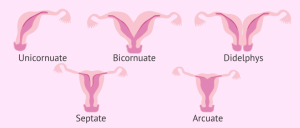#ThursdayThoughts
As promised, each Thursday, we will now offer you a piece of educational, science, or research related information. The purpose of our #ThursdayThoughts post is to share with you fact-based content that can enlighten and assist you on your fertility journey. Enjoy our post! Helping to Create New Beginnings….
Müllerian Anomalies: Diagnosis and Management of Abnormal Uterine Shapes
An abnormally shaped uterus is a type of ‘Müllerian anomaly’ which can impact reproduction through effects on fertility, fetal loss, and preterm labor. During early embryologic development, the female reproductive tract undergoes a series of steps including joining of two structures called Müllerian ducts, and then regression of a septum. Abnormalities in development of the uterus can lead to various types of anomalies, depending on which step in development was impacted. For example, incomplete fusion of the Müllerian ducts is the cause of anomalies such as bicornuate uterus (two uterine horns), while incomplete septum regression leads to persistent uterine septum (a midline uterine division). More severe abnormalities, such as absence of the uterus and upper vagina, can occur with complete failure of Müllerian duct development. Since the urinary tract develops alongside the Müllerian system, some uterine anomalies are associated with kidney abnormalities as well.
While many women with uterine abnormalities have normal healthy pregnancies without realizing they have any issue at all, certain Müllerian anomalies are associated with higher rates of fertility and obstetric complications. A saline infusion sonohysterogram (SIS) and/or a hysterosalpingogram (HSG) are routine parts of fertility evaluations which evaluate uterine shape. If an abnormality is noted, additional testing may be indicated. For example, a 3D ultrasound and/or pelvic MRI may be required to differentiate between certain abnormalities, such as bicornuate uterus and septate uterus. Depending on findings, a renal ultrasound to evaluate for concurrent kidney abnormalities, may also be ordered.
Treatment of Müllerian anomalies depends on the nature and severity of the anomaly, as well as the patient’s prior fertility/obstetric history and her desire for future childbearing. While some of the anomalies are not surgically treated, abnormalities such as septate uterus can be corrected in order to improve the chances of conceiving and carrying a pregnancy to term. Recent advances in treatment of Müllerian anomalies have even allowed for the possibility of a uterine transplant in patients with complete agenesis of the uterus.
If you have questions regarding the diagnosis and treatment of Müllerian anomalies, please call 808-545-2800 to schedule a consultation with a physician at the Fertility Institute of Hawaii, or visit our website at https://www.ivfcenterhawaii.com/ for more information.
